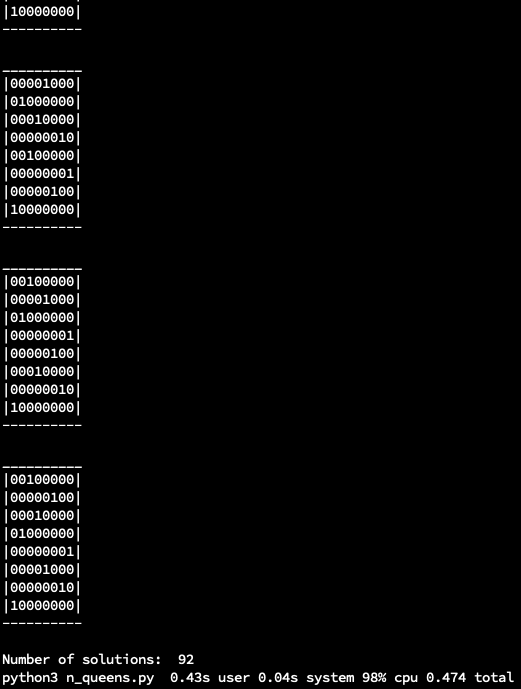I am reading the second edition of “The Algorithm Design Manual” recently. Reaching the chapter about backtracking, I realized that this method could solve many problems, even complicated problems, quickly and efficiently. Therefore I plan to write a solution to the n-queens problem by using backtracking.
Here is my Python code (Github):
# Using backtracking to resolve n-queues problem
import numpy as np
max_columns = 8
max_rows = max_columns
def print_chess(problem):
head = "_" * (len(problem) + 2)
tail = "-" * (len(problem) + 2)
print(head)
for row in problem:
row_str = "|"
for item in row:
row_str += str(item)
row_str += "|"
print(row_str)
print(tail + "\n")
def remove_diagonal(problem, occupied_coordinate, max_cols, candidates):
row, col = occupied_coordinate
step = max_cols - col - 1
# remove right-down
if (row + step) < len(problem) and (row + step) in candidates:
candidates.remove(row + step)
# remove right-up
if (row - step) >= 0 and (row - step) in candidates:
candidates.remove(row - step)
def construct_candidates(problem, k) -> int:
if k <= 0: # for first column
return [0] # return 'first row' if it is a 1x1 chess
else:
# find empty rows
candidates = set(range(len(problem)))
for col in range(k):
for row in range(max_rows):
if problem[row][col] > 0:
# remove queens in the same row or same column
if row in candidates:
candidates.remove(row)
# remove queens in the same diagonal
remove_diagonal(problem, (row, col), k, candidates)
return list(candidates)
# check all rows to make sure they all have queues ('1')
def is_solution(problem, k):
result = True
for index in range(min(k, len(problem))):
if sum(problem[index]) <= 0:
result = False
return result
def construct_solution(problem, candidate, k):
new_problem = problem.copy()
new_problem[candidate][k - 1] = 1
return new_problem
def solve(problem, k):
if is_solution(problem, k):
print_chess(problem)
return 1
else:
count = 0
candidates = construct_candidates(problem, k)
for candidate in candidates:
new_problem = construct_solution(problem, candidate, k)
count += solve(new_problem, k + 1)
return count
if __name__ == "__main__":
# try to resolve a max_rows x max_columns chess matrix
initial_problem = np.zeros((max_rows, max_columns), dtype=int)
count = solve(initial_problem, 1)
print("Number of solutions: ", count)I use NumPy for operations of the “chessboard” (matrix) as it’s extremely efficient.
The previous time I wrote code for the n-queens problem was in 2001, which was 20 years ago. The data centre of my school just gave us some old Intel 486 machines for practice, since we were not students of the computer science department (they keep the newest machines for their own students). The eight-queues problem cost about a half-hour to run at that time. But now it will only cost half a second on my laptop:

See how Moore’s law works in the recent 20 years.